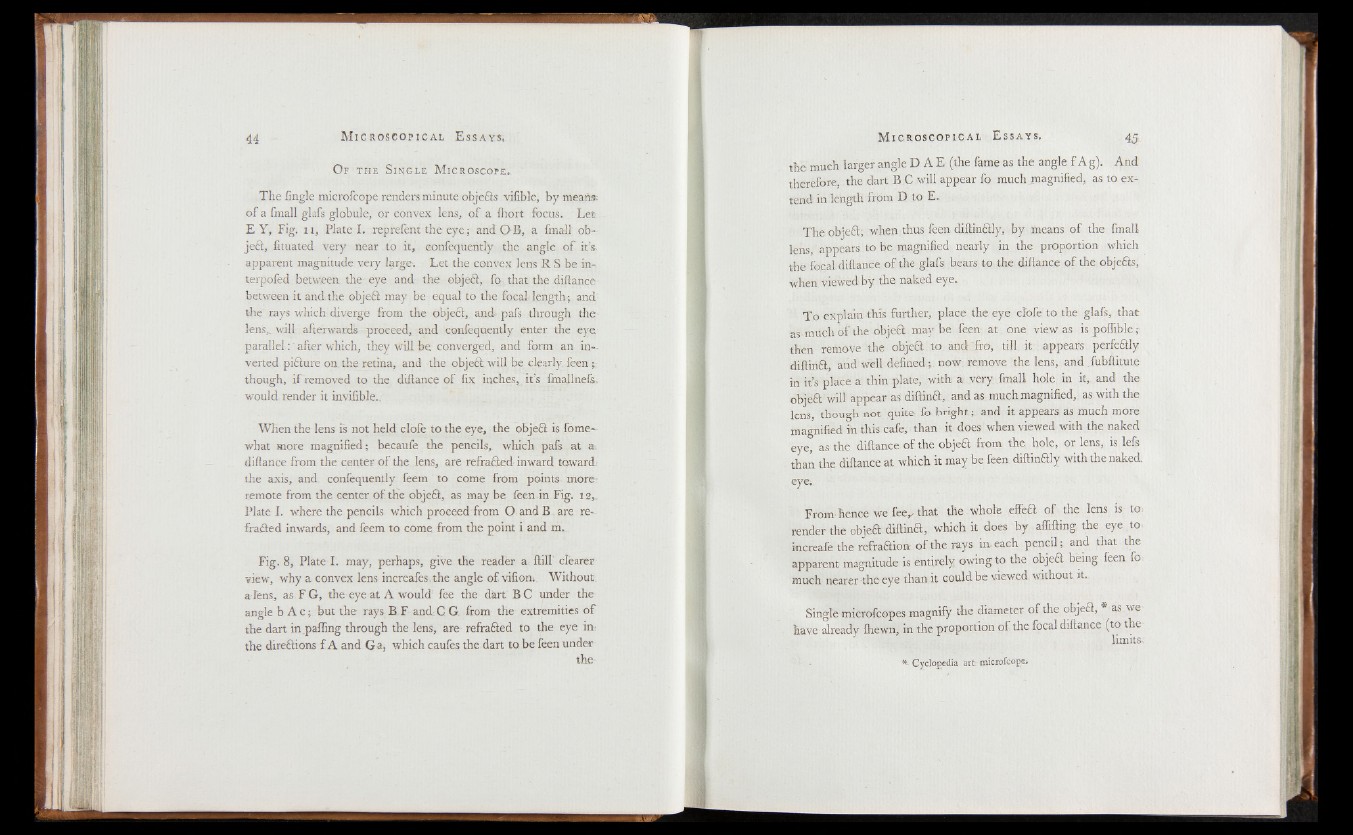
O f t h e S i n g l e M i c r o s c o p e ..
The Angle microfcope renders minute objefts vifible, by mean*
o f a fmall glafs globule, or convex lens, o f a fhort focus. Let
E Y , Fig. 11, Plate I. reprefent the eye; and O B , a fmall objea
, fituated very near to it, eonfequently the angle o f it’s-
apparent magnitude very large-. Let the convex lens R S be in-
terpofed between the eye and the object, fo that the diliance
between it and. the objeft may be equal to the focal length ; and
the rays which diverge from the object, and pafs through the-
lens,, will afterwards- proceed, and eonfequently enter the eye
parallel: after which, they will be converged, and form an inverted
picture on. the retina, and the ob jea will be clearly, feen ;
though, if removed to the diliance of fix inches,, it’s Imallnefe.
would render it invifible..
When the lens is not held clofe to the eye, the objea is fome-
what more magnified; becaufe the pencils, which pafs at a;
diliance from the center o f the lens, are refra&ed inward toward
the axis, and eonfequently feem to come from points more
remote from the center o f the object, as may be feen in Fig. 12 ,
Plate I. where the pendls which proceed from O and B are re-
fracted inwards, and feem to come from the point i and m.
Fig. 8, Plate I. may, perhaps, give the reader a Hill clearer
view, why a convex lens increafes.the angle o f vifion, Without
a lens, as F G, the-eye at A would' fee the dart B C under the
angle b A c ; but the rays B F and.C G. from the extremities o f
the dart in pafling through the lens, are refrafted to the eye tbs
the direftions f A and Ga, which caufes the dart to be feen under
the
the much larger angle D A E (the fame as the angle f A g). And
therefore, the dart B C will appear fo much magnified, as to extend
in length from D to E.
The objecl; when thus feen diltinctly, by means o f the fmall
lens, appears to be magnified nearly in the proportion which
the focal diliance of the glafs bears to the diliance of the objefils,
when viewed by the naked eye.
T o explain this further, place the eye clofe to the glafs, that
as much of the object maybe feen at one view as is polfible;
then remove the objea to and-'fro, till it appears perfectly
dillinfl and well defined.; now remove the lens, and fubllitute
in it’s place a thin plate, with a very fmall hole in it, and the
objeft will appear as diltincl, and as much magnified, as with the
lens, though not quite fo bright; and it appears as much more
magnified in this cafe, than it does when viewed with the naked
eye, as the diliance of the objea from the hole, or lens, is lefs
than the diliance at which it may be feen diltinaiy with the naked
eyei.
From hence we feeK that the whole elfea of the lens is to.
render the objea dillina, which it does by affifting the eye to
increafe the refraaion o f the rays in. each pencil; and that the
apparent magnitude is entirely owing to the objea being feen fo
much nearer the eye than it could be viewed without it..
Single microfcopes magnify the diameter o f the pbjea, as we
have-already Ihewn, in the proportion of the focal diliance (to the
limits;
Cyclopedia art microfcope.*